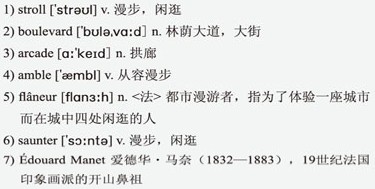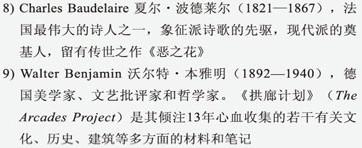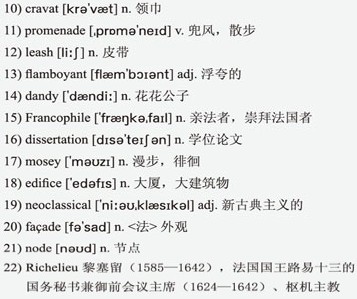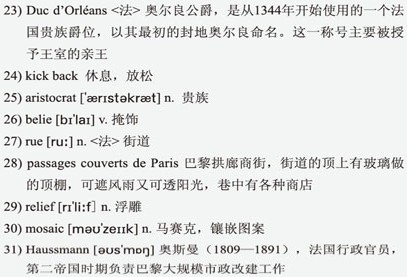We cross Rue des Petits Champs to visit elegant Galerie Vivienne, which in 1823 marks Paris' first wave of development of the 28)passages couverts de Paris. Bernard points out the classical 29)reliefs and marble 30)mosaic floors that we've walked across dozens of times but barely noticed, the neoclassical details encouraged by “Emperor” Napoleon to evoke classical times.
我们穿过小场街去参观雅致的薇薇安廊巷,其建于1823年,标志着巴黎拱廊商街的第一波发展浪潮。贝尔纳指出了那些我们行走过无数次却没怎么留意的古典浮雕作品和大理石拼花地板,以及拿破仑“皇帝”倍加推崇的,用以唤起古典时期回忆的那些充满新古典主义风格的建筑细节。
For the next couple of hours, like flâneurs we leisurely saunter the broad boulevards. We stroll to Place de L'Opera to take in the extravagant Opera Garnier, the centrepiece of a symbolic space. We wander around to Boulevard 31)Haussmann and duck into Société Générale to admire the majestic iron and glass interior and sneak down to the basement to 32)gawk at the gigantic bank vault. We drop into the gorgeous late 19th century department store, Galeries Lafayette, to gaze up at its breathtaking 33)Art Nouveau glass dome, and we continue our mosey along Boulevard Haussmann.
在接下来的几个小时里,我们就像城市漫游者们一样,悠闲地在宽阔的大道上闲逛。我们信步来到剧院广场一睹奢华的巴黎歌剧院,这是一块具有象征意义之地的焦点所在。我们在奥斯曼大道上徘徊,随后进入法国兴业银行去欣赏其内部宏伟的钢铁和玻璃装饰,然后再溜进负一层仰望那银行的巨型拱顶发呆。我们还顺便去了建于19世纪晚期那华美的百货商店老佛爷百货,凝望其震撼人心的新艺术风格玻璃圆顶,然后我们继续沿着奥斯曼大道漫游。
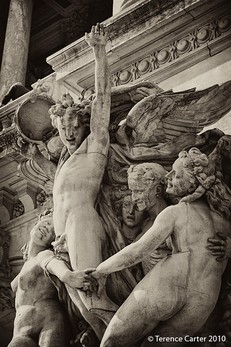 All the time Bernard points out architectural details which he situates within an historical context, vividly bringing the past into our present, and really making the period come alive. By the time we arrive at the beginning of Rue Réaumur, the focus of Bernard's research, we're rather pleased to realise our senses are so heightened to the city that surrounds us we can now easily spot the changes in architectural styles and 34)discern the dramatically different streetscape ahead of us.
All the time Bernard points out architectural details which he situates within an historical context, vividly bringing the past into our present, and really making the period come alive. By the time we arrive at the beginning of Rue Réaumur, the focus of Bernard's research, we're rather pleased to realise our senses are so heightened to the city that surrounds us we can now easily spot the changes in architectural styles and 34)discern the dramatically different streetscape ahead of us.
贝尔纳一路上都在为我们指出建筑上的细节,并将历史背景融入其中,将过去的时光生动地带到了当下,也确实让那些时代变得鲜活起来。当我们到达荷慕尔路的起点(贝尔纳研究的重点)时,我们相当开心地发现,我们对身处的这座城市的感知力大大地提高了,现在我们也能够轻松地分辨出建筑风格的变化,察觉到我们前方街景的显著不同之处了。
We cross Rue Réaumur and conclude our walk on narrow Rue Dussoubs, one of the remaining lanes of the old city. “This is typical of the 35)pre-Haussmann era architecture,” Bernard tells us, pointing to the medieval stone. “The bottom stories were shops that opened to the street and tiny passages led to the living quarters at the back, so social and economic life was tied here. These were the homes of the rebellious people, the ones who were pushed out of the city by Haussmann to the edges of Paris. They were highly unhygienic places, people lived in 36)appalling conditions, but there was a social life here, and these were people's homes.”
我们穿过荷慕尔路,在狭窄的迪苏路,也是旧城尚余的其中一条小巷,结束了我们的行程。“这是典型的前奥斯曼时代的建筑,”贝尔纳指着那些中世纪的砖石对我们说,“最底层是临街的商铺,小过道通向后面的生活区,就这样,社会和经济生活在这里交汇。这些曾经是起义民众的住所,他们被奥斯曼驱逐出城,赶到了巴黎的边缘。这些地方过去非常不卫生,人们的生活条件很恶劣,但这里也有社会生活,这里也是人们的家园。”
In a few hours, we've learned how Paris changed so radically and so rapidly and on a scale unprecedented, resulting in a chaotic medieval city becoming a very rational modern one.
在几个小时之内,我们就了解到了巴黎是如何彻底而迅速地发生了空前的转变,从一座混乱的中世纪城市变成了一座非常规整的现代城市。
Benjamin's flâneur may have been highly perceptive but he was a distant observer, yet if anything by the end of our three-hour walk, we feel closer to the streets of Paris than we ever have before. 37)Merci Bernard.
本雅明笔下的都市漫游者也许对这座城市进行过非常敏锐的观察,但他也只是一个远远的旁观者罢了。而如果说这三个小时的漫游结束后给我们留下了什么的话,那就是我们感到自己对巴黎的街道有了一种前所未有的亲近感。谢谢你,贝尔纳。
